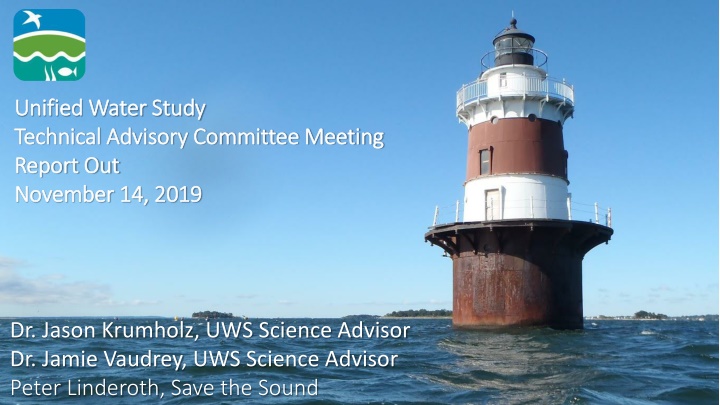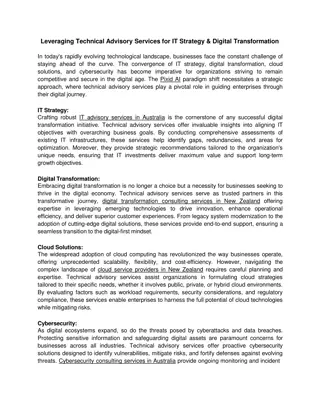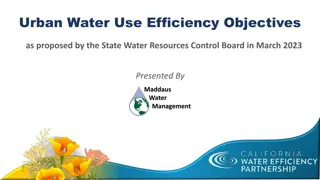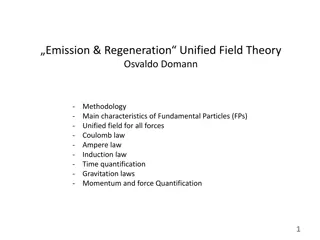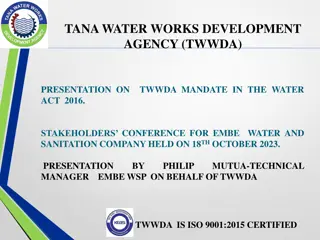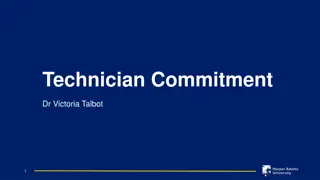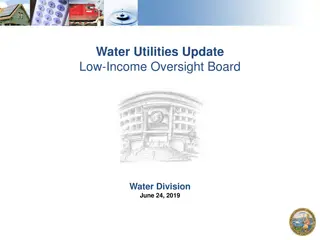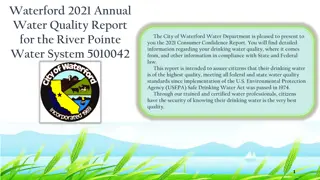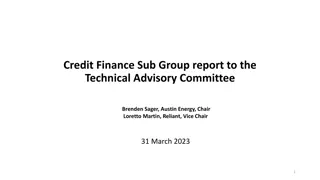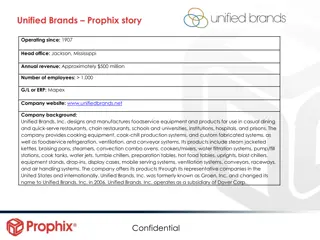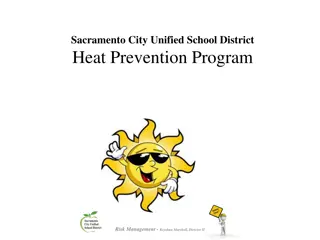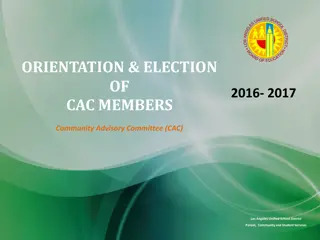Unified Water Study Technical Advisory Report
This report from the Unified Water Study Technical Advisory Committee meeting on November 14, 2019, discusses deep vs. shallow water characteristics, water quality indicators, monitoring parameters, and considerations for sampling programs. It touches on the correlation between oxygen levels, productivity, and eutrophication in different water systems.
Download Presentation

Please find below an Image/Link to download the presentation.
The content on the website is provided AS IS for your information and personal use only. It may not be sold, licensed, or shared on other websites without obtaining consent from the author.If you encounter any issues during the download, it is possible that the publisher has removed the file from their server.
You are allowed to download the files provided on this website for personal or commercial use, subject to the condition that they are used lawfully. All files are the property of their respective owners.
The content on the website is provided AS IS for your information and personal use only. It may not be sold, licensed, or shared on other websites without obtaining consent from the author.
E N D
Presentation Transcript
Unified Water Study Unified Water Study Technical Advisory Committee Meeting Technical Advisory Committee Meeting Report Out Report Out November 14, 2019 November 14, 2019 Dr. Jason Krumholz, UWS Science Advisor Dr. Jamie Vaudrey, UWS Science Advisor Peter Linderoth, Save the Sound
Deep vs. Shallow Water N Load N N N N N N O2 O2 O2 O2 O2 N Load N CO2+H20=Sugar+O2 O2 O2 O2 N N O2
SHALLOW Fully mixed Light reaches to the bottom DEEP Seasonally/episodically stratified Light does not reach bottom Typically dominated by phytoplankton Bottom water oxygen levels correlated with both productivity and stratification Typically dominated by macroalgae (and/or eelgrass) Oxygen levels have strong daily cycle driven by productivity and can experience supersaturation which is a eutrophication indicator. Total Nutrient level in water column is a good indicator of system productivity Bottom water oxygen levels are a good indicator of eutrophication Total Nutrient level in water column not well correlated with system productivity Oxygen levels during the day not necessarily correlated with eutrophication
POORER WATER QUALITY Sunlight + nutrients fuels primary productivity. Sunlight in shallow systems often reaches the bottom. BETTER WATER QUALITY Symbols courtesy of the Integration and Application Network, University of Maryland Center for Environmental Science (ian.umces.edu/symbols/).
UWS Parameters Tier 1 Dissolved Oxygen Turbidity Chlorpophyll a Qualitative Macrophytes Temp. & Salinity Tier 2 Continuous Dissolved Oxygen Quantitative Macrophytes Nutrients 6 Month Monitoring Season: May October Tier I WQ Twice a Month Tier I Macrophytes 3 Times in Set Interval Tier II Nutrients Twice a Month Tier II Loggers checked every 7-10 Days Tier II Macrophytes 1 day during set interval https://landscapelightingguru.com/comparing-landscape-lighting-bids-apples-to-apples/
Pros and Cons Literature Values: Relatively defensible values. Doesn t pre-suppose A-F range among sampled systems Values not specific to system in question. Difficult to determine useful literature values for innovative techniques Historical Data: Specific to system in question. Ideal in situations where reference state is clearly discernable Requires data rich system. Does not work with innovative metrics. Susceptible to shifting baselines Existing Sampling Program: Specific to system and timeframe in question. Don t have to deal with spatial/temporal mismatches Presumes range of values encountered spans range from excellent to poor . makes comparisons with other programs difficult Biological Thresholds: Mitigates anthropocentric viewpoint. Tied to management objectives. Not always available. Biological reference points may not always align when multiple uses exist
Our Preliminary Preliminary Thoughts A hybrid approach blending data from our existing monitoring program, supplemented by biological reference points where feasible, and literature values as necessary. Utilize WQ data from eelgrass supportive embayments in LIS as upper baseline (e.g. minimally supportive of eelgrass = A-). Cross check worst scoring LIS embayments against literature values to establish grade for lowest scoring systems. Don t want to automatically fail worst scoring embayments. Conversely, don t want to give a marginally passing score if substantial improvement is needed to meet water quality objectives. Initial grading metric focused on T1 only, T2 and some T1 data (e.g. macrophytes) used qualitatively in separate metrics. Establish some sort of Susceptibility Score based on embayment size, residence time, and location in LIS to compare with grade and show which systems are doing well/poorly relative to LIS mainstem waters with which they exchange?
Oxygen Discussion A Oyxgen metric needs to reflect both hypoxia and supersaturation Assigning a supersaturation grade won t work because it will artificially improve the grade of reliably hypoxic systems that don t supersaturate, and vice versa A bell shaped grading profile makes the most sense in this situation C 8mg/L 100% 0mg/L 150%
